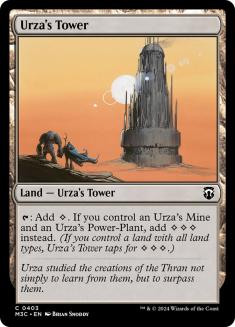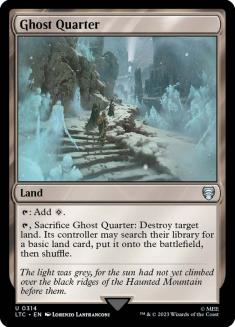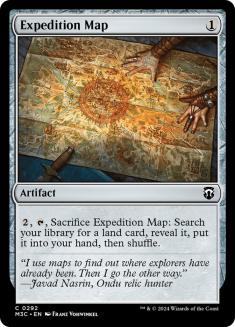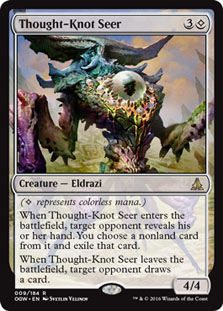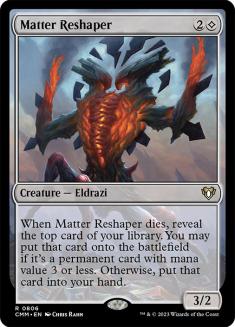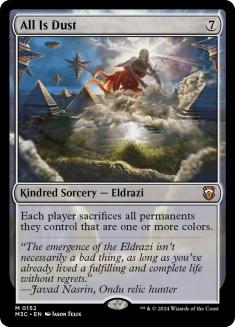While everyone else jams on about Hogaak, Arisen Necropolis or Bridge from Below being banned on July 8th, I’m watching a different clock for Modern.
The London mulligan hits Magic Arena and Magic Online on July 2nd with an early release of Core Set 2020. That’s literally tomorrow as you are reading this. On a game-by-game basis, the London mulligan might be even more impactful. Not everyone plays Bridgevine, even if they should. Everyone will have to live with the London mulligan.
As someone who spent a lot of time testing with the London mulligan for, well, Mythic Championship II in London, I’m here to guide you into the future of Modern and kinda the rest of Magic.
What’s The Big Deal?
If you briefly tuned in to coverage of Mythic Championship II, or maybe just checked out decklists, it might be hard to see what the London mulligan does to the game. It’s a very subtle change from the outside, and also extra insidious because many of the changes come from people figuring out how to adjust their plays over time.
Here’s the quick version.
The London mulligan largely doesn’t impact the cards you put in a given archetype. Your goals are still the same: do something powerful, and do it as consistently as possible. The biggest impacts are second-order effects, where because some other deck gets distinctly better, you shift your deck.
The Azorius Control decks at Mythic Championship II were often playing a Ghost Quarter as a fifth Field of Ruin alongside maindeck Surgical Extraction because they knew they had to fight Dredge and Tron. The Tron decks might start a second Ghost Quarter for mirrors and an extra Relic of Progenitus. Humans…. yeah, Humans didn’t change anything.
What the London mulligan does is maximizes your ability to assemble your best starts, as long as they can be assembled with one or two fewer cards. The common Vancouver mulligan issue where your land-spell balance is off because you are working with less cardboard is really mitigated.
If your opening hand isn’t something you would consider a strong start for your deck, you probably should mulligan it. If this last statement is true but you are concerned that you can’t reliably find a better hand, you might want to find a better deck.
“Your best starts” also includes sideboard cards. Your opponent will have their clean-kill sideboard cards very often, but you will also be much more able to access your counterplay to them.
“Your best starts” also is key on the plural part. You need to have redundancy of openings to find them over your first couple of tries. The combos of “single card plus other single card with no replacements” just don’t work here. You need tutors, replacement copies, or just something to get there. Bonus points if the routes all overlap and aren’t weirdly unique, which is just a way I can throw shade at Grishoalbrand for casting Faithless Looting and being unsure whether to discard Griselbrand for Goryo’s Vengeance or hold it for Through the Breach.
A lot more of the game is front-loaded. Knowing your openings in a chess-like fashion is very important so you know who comes out ahead in common patterns and how you can break them.
New Decks, New Mulligan
We learned a lot about how the London mulligan impacted the old decks of Modern in actual London. Dredge and Tron zipped right up to a completely new level. Humans got a solid boost in throwing away hands without a one-drop, along with a trophy because it avoided the previously mentioned hate card subgames. Izzet Phoenix didn’t gain a lot, and lost a ton of ground to more reliable linear decks. Amulet Titan was basically dumped into the alley out back as people realized its fast kills already almost required half a card more than you started with, let alone being fast and functional when down a card.
Since Mythic Championship II so many things have happened in Modern, and we have a ton of new decks to discuss in that context. Not only has Modern Horizons hit with dozens of playable cards, War of the Spark wasn’t even legal for that event.
Do you remember when people were complaining about Karn, the Great Creator? That was such a quaint time. Now Mycosynth Lattice is just a part of Modern or something. 2019 is just a weird year.
Creatures (17)
Planeswalkers (4)
Lands (24)
Spells (15)

Let’s ride this Segway right into the most prominent Mycosynth Lattice deck. Mono-Green Tron is out. Eldrazi Tron is in. Karn, the Great Creator was the threat it needed that functions fine in the low-mana Mind Stone games and the big mana Urza’s Tower games.
Just by the Tron in the name, you know this deck is going to benefit from the London mulligan. I spent the back half of 2017 making fun of how bad the mediocre Eldrazi Tron hands people were “forced to keep” were, and now you just aren’t forced to keep any of that trash.
Now, every time you see a hand like this:
You can just snap send it back and hope for the best.
The question for Eldrazi Tron to answer is if the Eldrazi part actually makes the deck better. Mono-Green Tron suffered in London from the hate-antihate subgame. If you lost a Tron land, you were just down a turn. If they spent a fractional turn to set it up, like a Spell Pierce on a key Sylvan Scrying or just a Ghost Quarter activation, you would fall behind in the race with no recourse. Eldrazi Tron can utilize some of these non-Tron turns to perform relevant game actions. When I talked about understanding openings and playing to break the standard play patterns, this flexibility is huge.
But when both players are just jamming, how good are the Eldrazi even going to be? It’s not like Thought-Knot Seer is a playable Modern Magic card these days, and that’s even before the London mulligan. You could point to the moderate success Mono-Red Eldrazi had, but that’s more of a Simian Spirit Guide issue than an Eldrazi one.
I’m cautiously optimistic about Eldrazi Tron’s place in the Modern metagame tomorrow, but the emphasis is on the “cautiously” more than the “optimistic.”
Creatures (16)
Lands (19)
Spells (25)

While Eldrazi Tron looks mostly the same as it did in 2017, Death’s Shadow has received a huge facelift with Modern Horizons. We jumped from Grixis to Esper with the release of Unearth and Ranger-Captain of Eos, and now just dropped the blue for red to support a better card draw spell and more balanced mana. Turn 1 Serum Visions or Inquisition of Kozilek, Turn 3 Ranger-Captain of Eos is is an awkward set of costs to support.
I make no promises Mardu is the right build of Death’s Shadow tomorrow, though. A big part of dropping blue is also admitting you don’t want Stubborn Denial, and that might not be the case if you have to stop Neoform’s late starts or fast Chalice of the Void.
But Death’s Shadow in general? Definitely a beneficiary of the mulligan rule, both directly and indirectly. You can’t keep every hand, and Death’s Shadow’s normal mulligans were plagued by issues with blank conditional cards or one too many lands that are less frequent with the London mulligan. Inquisition of Kozilek and Thoughtseize are also good options, not because “Thoughtseize versus five-card hands” but because you are extra forced to have that generic early interaction to not die these days.
What about the white? Again, I like it. We didn’t see a ton of it this weekend, but the white sideboard options are still great. Path to Exile is really important against many of the threats we expect to see, compared to the less broad Lightning Bolt. Temur Battle Rage is the card currently not in the Mardu lists that might become very important, but it’s not like they can’t play a copy.
Death’s Shadow is going to be a winner in this shift, but there’s still a lot of work to do on the archetype if you want to play it.
Creatures (8)
Lands (18)
Spells (34)

Let’s get a quick recap in here. Izzet Phoenix was a bit of a loser of the London mulligan fight, but if Surgical Extraction remains broadly powerful due to lack of a ban it might get a boost relative to Mythic Championship II. Aria of Flame is a shockingly powerful end-game that invalidates a lot of things people are trying to do, and if your free interactive spell that also goes off with your kill condition isn’t squeezed between Humans and Tron and Dredge the way it was two months ago, things might be looking up.
Creatures (9)
Lands (19)
Spells (32)

Grixis Urza is going to be shredded by the London mulligan rule. Full stop.
If you remember Modern three months ago, I was really into Whir Prison right before jumping into testing for Mythic Championship II. So obviously I threw myself right into the deck testing for that event, and then promptly threw my lists right in the trash after testing the obvious matchups.
The problem with all of these no-interaction artifact setup decks is they are operating on such slim margins before they turn the lock or combo corner. Then these other decks start London mulliganing and your plan is garbage-tier.
I really have nothing against Urza, Lord High Artificer as a card. It is just inherently broken as a mana engine that pays for itself immediately. But this list isn’t going to cut it.
Creatures (24)
- 4 Birds of Paradise
- 2 Eternal Witness
- 4 Devoted Druid
- 2 Noble Hierarch
- 2 Duskwatch Recruiter
- 1 Walking Ballista
- 4 Vizier of Remedies
- 1 Shalai, Voice of Plenty
- 4 Giver of Runes
Lands (21)
Spells (15)

Devoted Druid decks are a weird case we can learn a lot about the new mulligan rule from.
They are not a deck that absolutely maximizes the new mulligan rule. While it isn’t redundant, that redundancy isn’t consistent in power level. Having to Finale of Devastation or Eladamri’s Call for your Devoted Druid is not remotely the same speed as just drawing it.
But Devoted Devastation fits into a really nice spot where its good draw undercuts most of the other consistent decks, and it is flexible in the face of single hate cards. You aren’t going to get Chalice of the Voided, you are fairly resistant to Blood Moon and Ensnaring Bridge…I guess you just need to have a way around Plague Engineer on Humans now.
I think of all the decks I’ve listed, Devoted Druid is the next most likely behind Death’s Shadow to rework itself for the London mulligan. The reason is that it has a surplus of redundant options, so it might shift from a more balanced set to a more aggressive configuration. Less Eternal Witness, maybe a bit of Kitesail Freebooter-style interaction instead to ensure you are ahead of the clock every time.
Creatures (5)
Planeswalkers (7)
Lands (25)
Spells (23)

Azorius Control isn’t a new deck. It gained a ton from War of the Spark, but even these super-pushed planeswalkers are stuck as the kinds of cards that win the medium games of Modern. They aren’t the cards that win the optimized games of Magic you will be playing by next weekend.
Force of Negation is a huge gain, but I’m unsure Azorius is the right deck to utilize it as opposed to something with nut draws of its own. If anything, expect a slight backslide in Azorius lists towards cards being played earlier this year. The powerful single-shot effects like Terminus start looking more exciting when you need to match powerful hands and not just whittle people away over slower games.
Creatures (28)
- 4 Carrion Feeder
- 4 Bloodghast
- 4 Vengevine
- 4 Gravecrawler
- 4 Insolent Neonate
- 4 Stitcher's Supplier
- 4 Hogaak, Arisen Necropolis
Lands (19)
Spells (13)
Sideboard

Okay, I couldn’t not mention it.
Bridgevine is significantly less of a direct London mulligan winner than prior graveyard decks. Dredge needed very few cards to kick off the dredge-draw engine, where the extra material matters a lot in Bridgevine for getting your Zombie tokens or Vengevines going.
It’s more of a parallel with Humans, where you are a powerful deck looking for powerful starts. Everyone has to mulligan sometimes, and when you do, the odds of that follow-up hand being an awkward forced keep are just lower with the London mulligan.
The real question comes against graveyard hate. Bridgevine is significantly better at fighting fair than Dredge ever was. If you have just four Leyline of the Void and mulligan for it, do your five-card Leyline draws actually beat Bridgevine? Dredge would just mulligan down with you to a Nature’s Claim and win the weird low resource slow dredge game, but I don’t think Bridgevine has the same flexibility to play off four functional cards and a Wispmare.
If it turns out those virtual four-card hands just get beaten down by Gravecrawler and Bloodghast too frequently, I think Bridgevine still makes everyone play miserable nine-card-sideboard, six-graveyard-hate Magic. If mediocre beatdown loses to these small hands, that would unlock the format from what we see now without a banning. Showing up with four graveyard hate or a deck that naturally combats Bridgevine is a much more reasonable bar to clear than the current state of the format.
I will restate that these shifts will be subtle at first. I’m talking about these decks taking big shifts, but while the mulligan rule will literally change overnight, people’s opinions won’t. The London mulligan doesn’t turn Magic into no-variance chess. But it does turn a lot of close matchups into 45% with no adjustments, then 40% once people start mulliganing more, and then 30% as other optimized decks start pulling sideboard space and the adjustments creep in and push a deck out of the metagame.
It pays off to think a step or two ahead like this. You still need to verify, but thinking ahead and trying to adjust your plays is how you discover these changes before everyone else and come out with tournament-winning edges.


